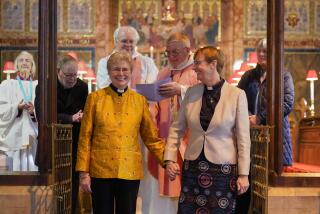London’s St. Paul’s is 300 years old but looks brand-new
- Share via
Reporting from London — Among the 2 million annual visitors to St. Paul’s Cathedral, the architectural and spiritual heart of London, only a few ever notice the grimy, charcoal-gray stone just inside the Great West Door.
It is, after all, just a single ugly slice of rock. And this isn’t the entrance the tourists and other commoners use. It’s the one through which Her Majesty the Queen enters.
That drab slab is surrounded by sparkling-white Portland stone, quarried three centuries ago about 90 miles southwest of London. With its heavy coating of grime, the single slab was intentionally overlooked during a recent cleaning that restored the magnificent landmark to its original grandeur in time for the 300th anniversary -- what the Brits call the “tercentenary” -- of the cathedral’s completion in 1710. Visitors now can see the masterpiece of its architect, Sir Christopher Wren, as he envisioned it in the late 17th century.
Cathedrals dedicated to St. Paul have stood on this site -- at the eastern edge of the City, London’s financial district -- since 604. Wren’s majestic monument is the fourth. The third, a 600-year-old structure of wood and stone, was gutted in the Great Fire of London in September 1666.
Wren wasn’t trained as an architect -- he was an astronomy professor at Oxford -- but he was one of the great intellects of his day, keeping company with the likes of Isaac Newton. So when the need for a new building arose, King Charles II turned to Wren.
His achievement -- a vast, cross-shaped building -- continues to dominate the skyline. Soaring to 365 feet, its dome was the first in England. It has been a welcoming beacon ever since, and particularly so for 2010, when St. Paul’s invites visitors to celebrate the anniversary by seeing for themselves the remarkable results of a multimillion-dollar renovation of what experts say is Wren’s greatest achievement.
“Wren was trying to do a very contemporary building, a very forward-looking building,” says architect Martin Stancliffe, the cathedral’s 17th Surveyor to the Fabric, the person in charge of a cathedral’s upkeep. Wren was the first person to hold the position at St. Paul’s.
“[Now] we can travel around the world to look at other buildings. Wren never crossed the Alps. He never went to Rome. He never saw St. Peter’s or the great buildings of Italy.
“He would never have seen a completed dome and certainly nothing on this scale,” Stancliffe continues as a nearby church bell chimes 9 o’clock. “What he was doing was creating a building in his mind . . . that he could then realize without any parallels.”
The construction, begun in 1675, continued for 35 years, under the watchful eyes of five monarchs.
St. Paul’s continues to play a key role in the fabric of English life. During the Blitz of 1940-41, the majestic dome stood silhouetted against the fires raging in east London, as floodlights scoured the night skies for Nazi bombers. The cathedral took several direct hits, but -- unlike several other Wren churches -- was relatively unscathed, becoming a testament to British resilience. More than 20 years later, the funeral for Britain’s wartime leader, Sir Winston Churchill, was held here.
In 1981, as the world watched, Prince Charles wed Lady Diana Spencer at St. Paul’s. It also hosted the 2006 celebration of Queen Elizabeth II’s 80th birthday.
In between the pomp and circumstance, the Anglican faithful gather here for more than 1,700 church services each year. They sit not in regal wooden pews but on 2,500 simple plastic-and-metal chairs.
On bright days, sunlight streams through the windows, illuminating the results of a decade-long, $64-million face-lift overseen by Stancliffe. The privately funded renovations, timed for completion before this year’s tercentenary, began with a restoration of the exterior stonework before moving indoors.
“The whole interior of the cathedral . . . had got a very kind of shabby, dirty, tired appearance and feel, which was actually making it an unrewarding place to be in,” he says.
“One of the big things we’ve been able to do is comprehensively clean the interior, and that’s not a question of just dusting.”
The cleaning job took four years, partly because of Wren’s actions. In an effort to protect the newly quarried stone from deterioration, Wren had it covered with several layers of oil and paint. The coating served its purpose, but over the centuries it absorbed London’s dirt and smoke. It was against this bleak backdrop that Charles and Diana’s fairy-tale wedding was held; observers say the dreariness was only partly disguised by the bright television lights.
Several earlier efforts to remove the grime -- the Victorians attacked it with abrasives -- failed. But Stancliffe discovered that the Belgians had invented a latex paste to successfully clean aged interiors. In the evening, after visitors had departed, the solution was sprayed onto the walls. Allowed to dry overnight, the paste, with centuries of soot attached, was peeled off the following morning. Only that one chunk of stone near the west entrance was left untouched as a reminder of the building’s former grimy state.
“Now you come in and it’s all bright and feels well looked-after,” Stancliffe says. “There’s a feel-good factor about it, which it didn’t have before.”
More to Read
Sign up for The Wild
We’ll help you find the best places to hike, bike and run, as well as the perfect silent spots for meditation and yoga.
You may occasionally receive promotional content from the Los Angeles Times.






